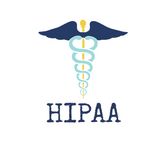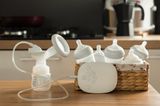I am seeing more and more clients who want to make larger and larger quantites of milk, and while having not enough milk for your baby has many challenges as does having too much milk. It is also very common to start with too much milk and actually end up with not enough.
Having oversupply is painful, it often means waking up in the night to empty your breast/chest even if your baby is sleeping peacefully. With overactive letdown, few parents experience as painful directly but it can be very challenging for the baby to manage and they may learn that having a shallow latch is safer for their airway which in turn leads to painful breastfeeding/chestfeeding and decrease in supply.
What's the difference between overactive let down and oversupply?
If you have overactive letdown/oversupply here are some tips to help understand better what is happening and some simple steps you can try to resolve it. Sometimes these issues are simple and resolve quickly but if they don’t its best to reach out to a virtual or in person lactation consultant who can help guide you.
Overactive letdown and oversupply are two related but distinct issues that can occur during breastfeeding or chestfeeding.
Overactive letdown refers to a situation where milk flows very quickly from the breast or chest tissue, often causing the baby to pop off and choke, sputter, or gulp during breastfeeding or chestfeeding. This can be caused by various factors, including an overabundant milk supply, a forceful letdown reflex also known as a milk ejection reflex, or an inefficient latch by the baby. The result is that the baby may swallow air along with the milk, which can cause discomfort, fussiness, or even colic.
Oversupply, on the other hand, refers to a situation where the body produces more milk than the baby needs. This can lead to engorgement, a feeling of fullness, or leaking milk between feedings. Oversupply can also cause the baby to struggle with breastfeeding or chestfeeding, as they may become overwhelmed by the amount of milk or struggle to keep up with the flow. They may also get milk that is too high in water and sugar content without enough fat, which can cause issues if it occures over a long period of time.
While overactive letdown and oversupply can be related, they are not the same thing. Overactive letdown refers specifically to the speed of milk flow, while oversupply refers to the amount of milk produced. It is possible to have one without the other, or both at the same time.
How do I know if I have oversupply or overactive letdown
Overactive milk ejection reflex (or letdown) and oversupply can have similar symptoms so it can be hard to tell if you have one or the other or both, but there are some key differences that can help you determine which issue you are experiencing. Here are some signs of each:
Signs of overactive letdown
- Baby chokes or sputters during feeding
- Baby pulls away from the breast or chest during feeding
- Baby gulps or swallows loudly during feeding
- Baby may appear uncomfortable or fussy during feeding
- Milk sprays from the breast/chest during letdown when baby pulls away
- Baby may get fussy towards the end of a feeding and still seem hungry after a feed if only overactive let down is present
Signs of oversupply
- Baby gains weight rapidly
- Baby may have frequent, explosive bowel movements, they may be green and frothy or even contain mucus
- Baby may have excessive gas or spit up frequently (this is not however the most common reason for frequent spit up)
- Breast or chest tissue may feel overly full or engorged even after the first week after birth
- Parent may experience frequent bouts of mastitis
Causes of overactive letdown without oversupply
Overactive milk ejection reflex is a common breastfeeding issue that occurs when milk is released from the breast or chest too quickly or forcefully during letdown. Some potential causes of overactive letdown include:
- An oversupply of milk (this is the most common cause though it isn’t always the case): When there is an oversupply of milk, the milk can come out too quickly and forcefully during letdown, leading to overactive letdown.
- Hormonal changes: Hormonal changes in the body, such as those that occur during the early weeks after birth, can affect milk production and letdown, leading to overactive letdown.
- Baby's latch: While a poor latch or sucking technique or tongue tie doesn’t generally cause overactive let down it can often have similar symptoms.
- Breast/chest engorgement: Engorgement can lead to overactive letdown, removing milk at regular intervals and treating oversupply is important to avoid this.
- Medical conditions: Certain medical conditions, such as thyroid disorders, can affect milk production and letdown as can medications used to treat them.
Causes of oversupply
There are several potential causes of oversupply while breastfeeding or chestfeeding . Here are a few common ones:
- Hormonal imbalance: An overproduction of milk can be caused by hormonal imbalances, such as high levels of the hormone prolactin. This can be due to conditions like thyroid issues or pituitary tumors.
- Overstimulation of milk production: Too frequent milk removal especially in the early weeks after birth, can signal the body to produce more milk than the baby needs. Generally putting the baby to the breast or chest very frequently does not cause over supply. What I see most often is people using a haakaa, other silicon pump or pump excessively when they don’t need to.
- Medications or herbal supplements: Certain medications or herbal supplements, medications like reglan used for nausea and vomiting has a side effect of increasing milk supply.
- Systemic inflammation: has also been seen clinically to cause over supply, this may be caused by an illness that you know about like an autoimmune disease but could also be caused by inflammation that is not otherwise clinically easily observable. Working with a specialist will likely be your best bet to understand if you have systemic inflammation.
Haakaa overactive letdown/supply
A Haakaa is a type of manual breast pump that is often used to collect milk from the opposite breast/chest while breastfeeding or chestfeeding. While a Haakaa can be a useful tool for collecting extra milk or relieving engorgement, it can also contribute to an oversupply of milk if not used carefully.
Using a Haakaa can stimulate additional milk production, especially if used frequently or for extended periods of time. This is because the suction from the Haakaa can trigger the letdown reflex and signal the body to produce more milk.
If you are using a Haakaa to collect milk, it is important to use it only as needed and not to overdo it. Some parents may also find that using a Haakaa on one breast/chest while nursing on the other can create an imbalance in milk supply, leading to an oversupply on one side. If you are using a Haakaa its important to make sure to switch which side you are using it on during the feeding or with each feeding.
Overall, while a Haakaa can be a helpful tool for breastfeeding mothers or chestfeeding parents, it is important to use it mindfully and with caution to avoid contributing to an oversupply of milk. If you are experiencing issues with oversupply, it may be helpful to talk to a lactation consultant or healthcare provider for guidance on how to manage it effectively.
Other milk collecting options
Some parents use the Haakaa to catch the milk leaking from the opposite nipple but this can make an over supply worse. If you are still wanting to catch that milk to use later or at least so it doesn’t get all over your clothes. There are other options that will not come with the same issues. There are several other types of milk catchers or human milk collection devices that can be used instead of a Haakaa. Here are a few examples:
Milk collection cups: Milk collection cups are worn inside a bra and collect milk that leaks from the breast/chest. They are designed to be discreet and can be used throughout the day to collect milk that would otherwise be wasted. These can be very helpful if you leak a lot between feedings.
Milk-saver shells: Milk-saver shells are similar to milk collection cups, but are designed to be worn directly on the breast/chest. They are also designed to collect milk that leaks out during breastfeeding/chestfeeding or pumping. These often have a small amount of suction so may have some of the disadvantages of a silicon pump like the haakaa.
How to treat oversupply
If you have an oversupply of milk while breastfeeding/chestfeeding, there are several strategies that can help you manage it. Here are some potential treatments:
- Nurse directly and frequently (if possible): Make sure to nurse your baby frequently, this gives the glandular tissue less time to become as engorged and generally reduces pain. This can help signal your body to produce the right amount of milk and reduce engorgement, it can take some time for this to work. Feeding your baby directly helps your body to become in sync with the quantity of milk your baby needs.
- Use block feeding: While this isn’t one I recommend often I have had clients say that this worked well for them. Instead of switching sides at each feeding, try nursing on one breast/chest for a longer period of time (e.g. 2-3 hours) before switching to the other breast. This can help regulate the amount of milk produced and reduce oversupply.
- Avoid pumping unnecessarily: Using a breast pump too frequently or for too long can signal your body to produce more milk than your baby needs. If you do need to pump to relieve engorgement, and pump for shorter periods of time, I recommend starting with 3 minutes and see if you are comfortable. If you are pumping instead of a feeding session make sure not to pump too often or for too long. Try and match the amount of milk your baby needs.
- Reduce systemic inflammation (which can be easier said than done, this will need direct guidance of a skilled provider)
- Consider medication or herbal supplements: In some cases, medication or herbal supplements, such as sage, peppermint, pseudoephedrine or certain birth control pills, can help regulate milk production. However, it is important to talk to your healthcare provider before taking any supplements or medications while breastfeeding. These can also be tricky to manage as they work differently for everyone and there is a real risk of ending up without enough milk for your little one.
Remember that managing an oversupply of milk can take time and patience. It is important to work with a lactation consultant or healthcare provider to find the strategies that work best for you and your baby.
How to treat overactive letdown
Here are some strategies that may be helpful for treating an overactive milk ejection reflex or letdown:
- Nurse in a reclined position: Nursing in a reclined position can help slow down the flow of milk and make it easier for the baby to manage.
- Take breaks during feeding: Allowing the baby to take breaks during feeding can help them manage the flow of milk and reduce discomfort.
- Pump before feeding: If you have a lot of milk, pumping a small amount before feeding can help reduce the pressure and make it easier for the baby to manage.
- Work with a lactation consultant: A lactation consultant can help assess for tongue tie and your breastfeeding/chestfeeding technique and provide guidance on how to manage an overactive milk ejection reflex.
It is important to note that these strategies may take time and practice to be effective, and it is important to work with a lactation consultant to determine the best approach for you and your baby. Additionally, if you are experiencing pain, discomfort, or other issues related to breastfeeding or chestfeeding, it is important to seek medical attention as soon as possible.




